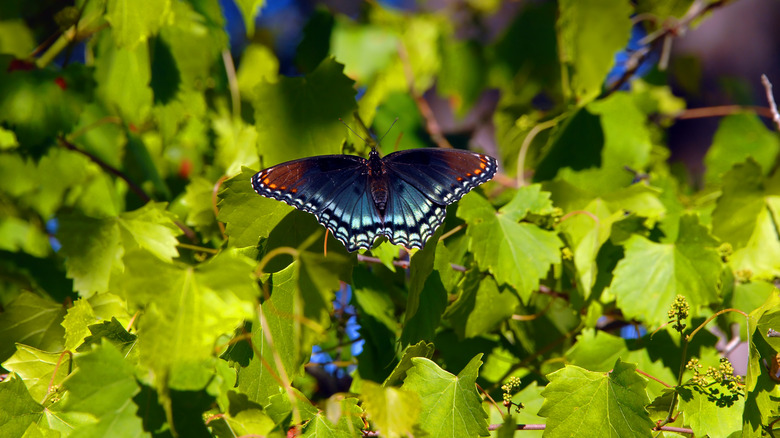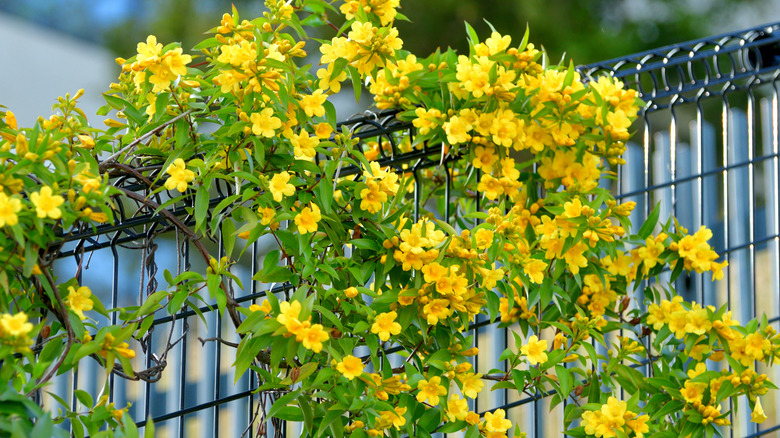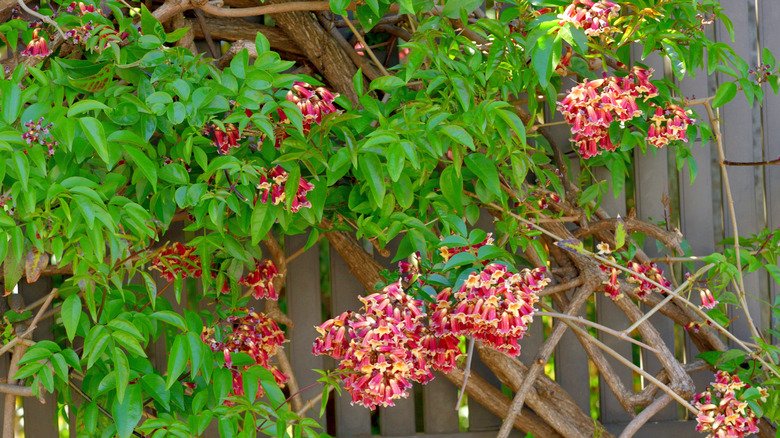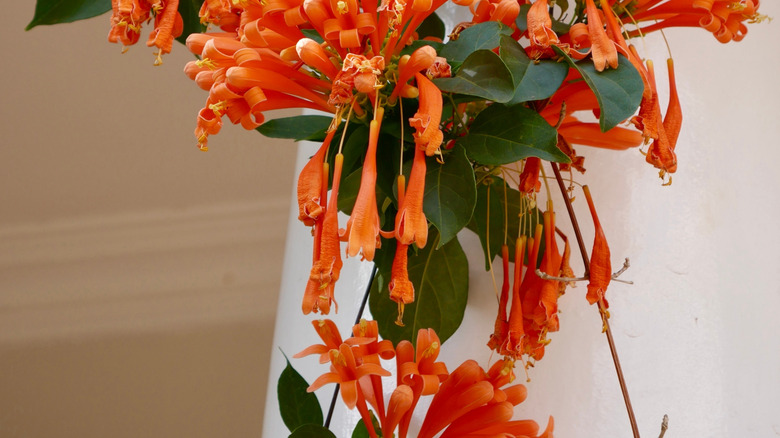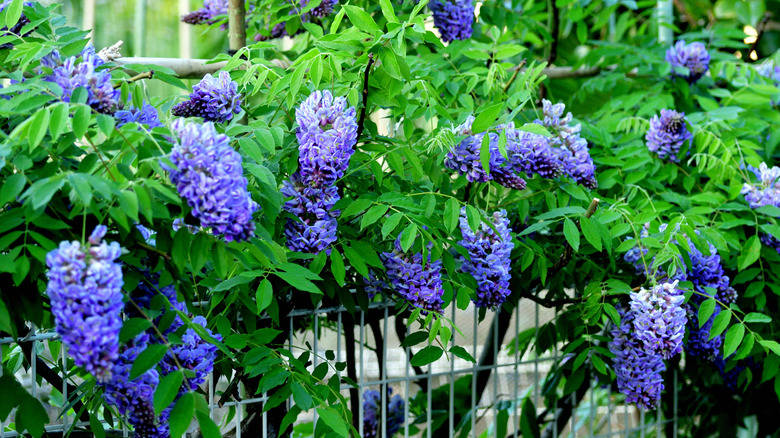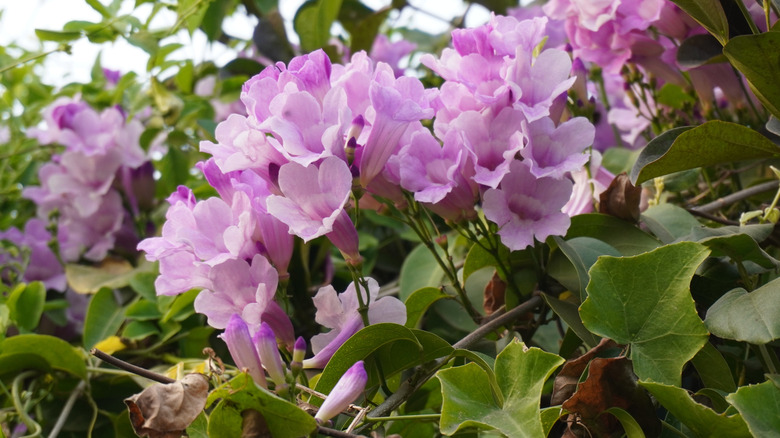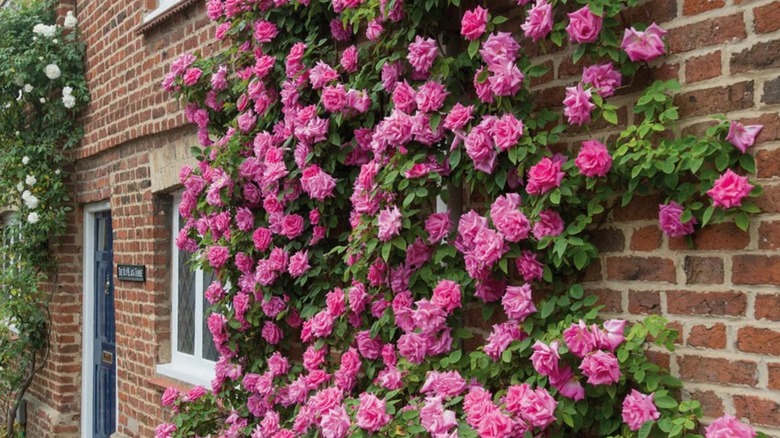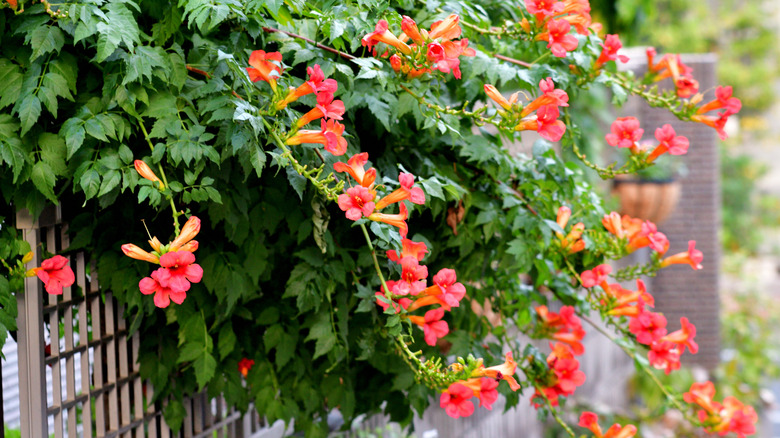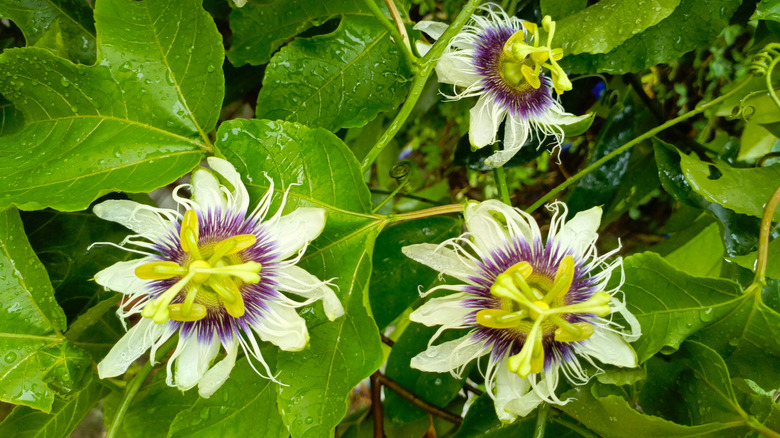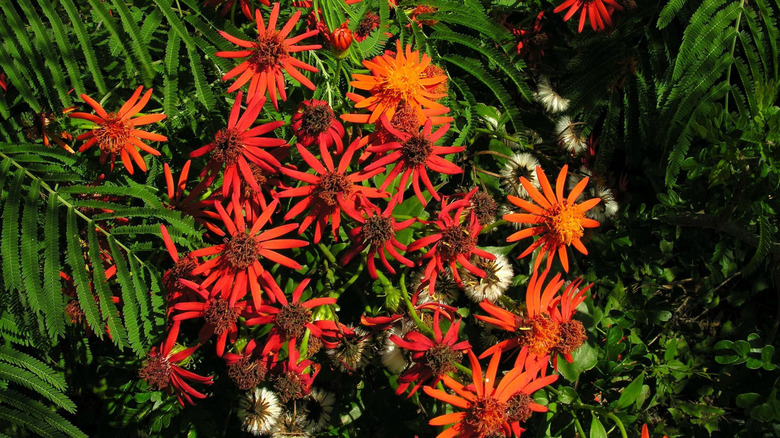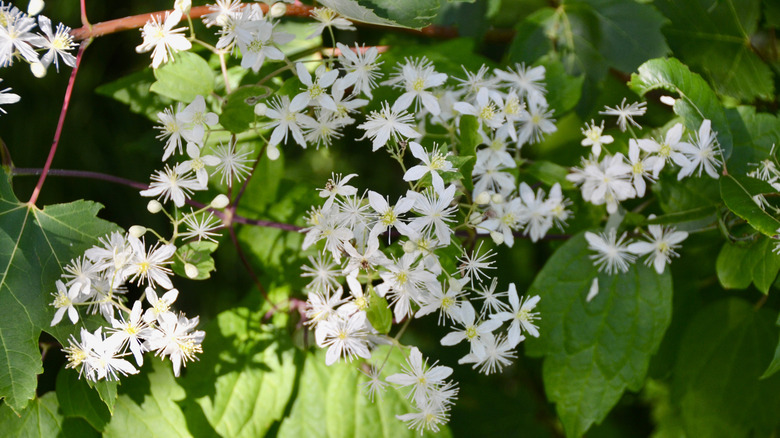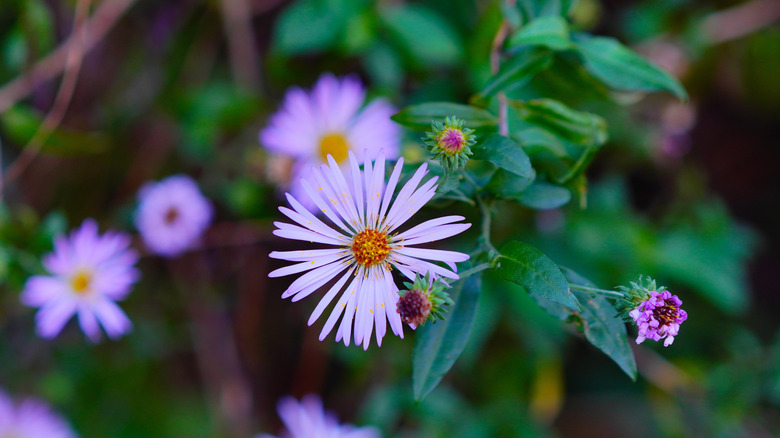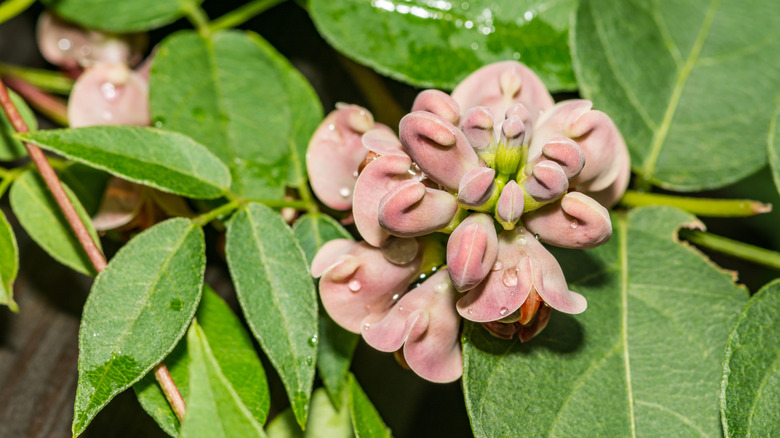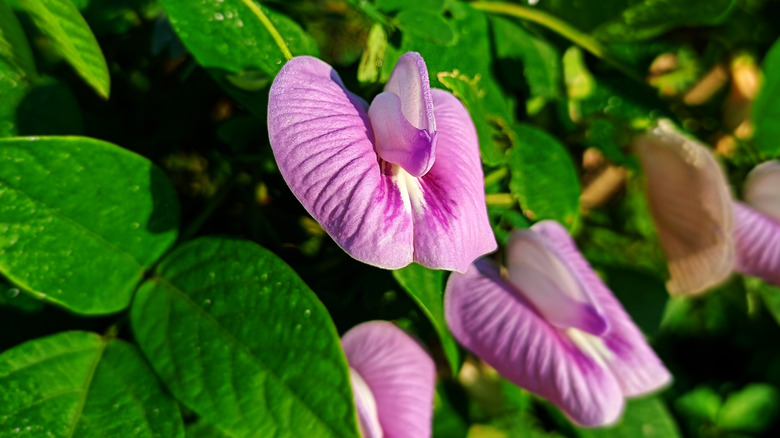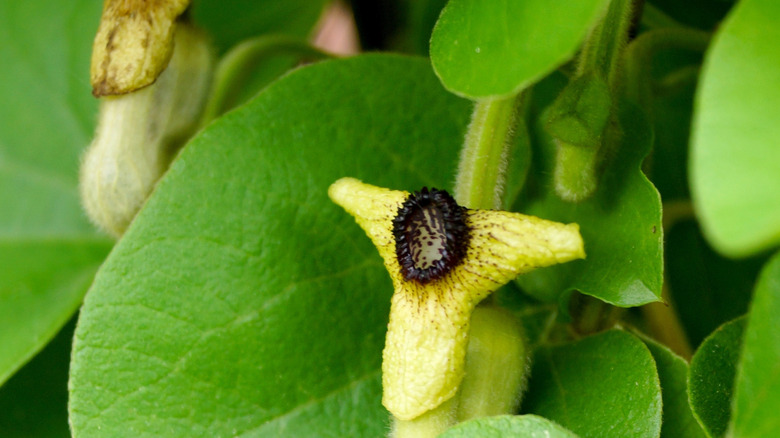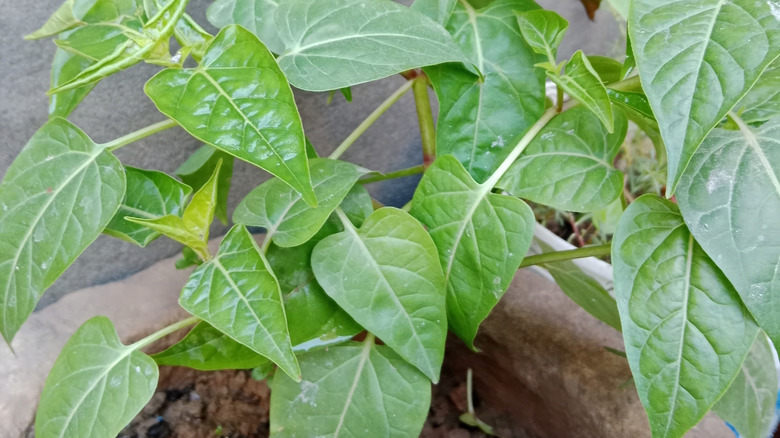These Climbing Plants Will Turn Your Backyard Into A Butterfly Haven
Flying flowers is how some define butterflies — and rightfully so. Flashing a rainbow of color, as they hungrily hover around and insert their proboscis into their pollen, butterflies present an awe-inspiring sight, rivaled only by the nectar producers. That they aid in plant pollination while refueling only adds to the beauty of having these breathtaking butterflies flying around your yard & garden. Though if you're partial to birdwatching, you've another reason to attract these charismatic fliers, as their caterpillars make protein-rich bird food.
Irrespective of the reasons underscoring your choice, you can grow many climbing plants to fill your garden with a variety of butterflies. Nectar-rich flowers, such as Carolina jessamine, crossvine, trumpet honeysuckle, violet trumpet vine, and Zéphirine Drouhin rose, are a few examples. Complement them with passionflower, butterfly pea, and Dutchman's pipe vines that encourage host-specific butterflies to reproduce on their foliage. This will help rescue their declining population — a 2025 study published in Science estimates their numbers have nosedived 22% since 2000 — and have your yard teeming with new pollinators.
However, remember a few pointers before choosing butterfly-friendly plants. Adult butterflies typically gravitate toward red, pink, orange, and yellow blooms. Ensure the chosen plants are sited in the sun because butterflies don't feed in shade. Mix in plants producing bigger blooms or flower clusters to accommodate larger butterflies, like swallowtails. Target successive planting, so nectar is available throughout spring through fall. With the basics established, let's discover the climbing plants sure to turn your backyard into a butterfly haven.
Carolina jessamine
Carolina jessamine (Gelsemium sempervirens) is a fast-growing climbing plant that'll turn your yard into a thriving haven for spicebush swallowtail butterflies along with hummingbirds and bees. They nectar at the climbing vine's canary-yellow flowers that, depending on the location, burst out in December or February and last through May. Sometimes, they also put out another flush in autumn. Plant Carolina jessamine in sunny sites with organically rich soils in zones 6 through 10 for the best blooms. Train them over a trellis or arbor and prune regularly to reduce volunteering. All plant parts are highly toxic if consumed.
Crossvine
Since crossvines (Bignonia capreolata) start producing their perfumed orange-yellow blooms by winter end, they serve as a critical nectar source for butterflies as the spring unfolds. Be certain to plant them in full sun so they bloom abundantly. As crossvines ascend with their holdfasts, they can harm wooden structures. So, it's important that the supporting structure is robust enough to bear their weight. Also known as trumpet flowers, crossvines can further fuel any incoming fire, which is why you shouldn't plant them within the defensible area. Note that they can turn very aggressive and outstrip their boundaries if their root suckers aren't clipped off regularly.
Trumpet honeysuckle
Native to the southeastern U.S., trumpet honeysuckle (Lonicera sempervirens), also known as coral honeysuckle, is quite attractive to butterflies. Adult ones adore the bright orange flowers blooming between late spring and summer for nectar. Spring azure butterflies lay their eggs on honeysuckle's leafy undersides. For the best display, ensure the vines are exposed to direct sunlight for at least six hours in zones 4 to 9. Trumpet vines are aggressive and can escape their bounds, though they aren't considered invasive. Cut back the climbing plant every year to encourage bushier bottom growth. Keep the flammable vines away from your home's defense zone.
American wisteria
American wisteria (Wisteria frutescens) might not be as theatrical as its Chinese counterpart, but it's a stickler for rules and stays within its limits, despite the vigorous growth. Better yet, native butterflies, including zarucco duskywing and long-tailed skipper, have adapted themselves to lay eggs on their foliage, while many others relish their nectar. Lilac or blue flowers mostly bloom between April and May, though deadheading may encourage a second flush in the summer. Accidental consumption of seeds can be poisonous, so site them where pets abstain from wandering. Don't forget these important fall tasks to ensure your native wisteria blooms beautifully in the spring.
Violet trumpet vine
Want a lush climber that isn't too thirsty? Opt for violet trumpet vine (Clytostoma callistegioides), an evergreen climber that becomes drought-tolerant after establishment. Butterflies throng to the trumpet-shaped lavender flowers in late spring when they literally obscure the deep green foliage and remain through summer. Given the dense canopies, you may use the vines for screening or shade and leave them be. But if you aren't iffy about pruning, you can train them as espaliers. They are cold hardy to 20 degrees Fahrenheit and prefer morning sun, particularly in hot regions. Pair them with crossvines for successive color.
Zéphirine Drouhin rose
Also popular as Bourbon rose, Zéphirine Drouhin rose (Rosa 'Zéphirine Drouhin') is a climbing plant perfect for your north-facing wall because it tolerates partial shade. As for butterflies, it attracts many when it blooms carmine pink roses from spring through frost, while infusing the landscape with a fruity fragrance. Relatively thornless, Zéphirine Drouhin can be trained over the fence or an arbor. It exhibits resistance to black spot and mildew. Tardy caregivers can leave the climbers be, though removing spent blooms will encourage new ones. These heirloom roses are hardy in zones 5 through 11.
Trumpet creeper
You might've heard of trumpet creepers (Campsis radicans) as flowering vines that will keep hummingbirds coming back to your yard. But butterflies too favor the sweet nectar pouring out of the vine's summer blooms. However, site your climbing plant carefully, as it tends to sucker and spreads aggressively, suppressing other plants. Keeping it around hardscape elements or areas where you can mow it down should help. Wear gloves before handling to prevent contact dermatitis. Ensure their support structure is solid — like metal or brick — because mature vines get quite heavy and may come loose.
Passionflower
Whether you call them maypops, apricot vines, or passionflower (Passiflora incarnata), a bevy of butterflies will seek them out regardless. A few enjoy the juicy nectar oozing out of their purple-crowned flowers all summer. In contrast, others like zebra longwing, gulf fritillary, and variegated fritillary, will trust their tear-shaped foliage to see their caterpillars through pupation, especially in Florida and Texas, where these vines originate. Caterpillar damage may temporarily tatter the showy vines, but not irreparably. Passionflower vines are great for dry, shaded sites, though the best blooms appear in full sun. Keep deadheading and pruning to keep them under control.
Mexican flame vine
Do you have an unattractive chain fence or post that could use a color boost? Then, consider Mexican flame vine (Pseudogynoxus chenopodioides, previously Senecio confusus). This drought-tolerant, well-behaved climbing vine is covered in orange-red flowers throughout the year, with spring and summer being the showiest seasons. By planting them, you can attract monarch butterflies to your garden. They're evergreen in zone 9 and south but must be replanted every year in cold climates where they experience die-back. If you live in a rainy area, plant Mexican flame vines in berms to ensure quick drainage, or they'll perish.
Virgin's bower
Virgin's bower (Clematis virginiana) is another climbing plant you should grow on your property to attract butterflies — the Lepidoptera family, in particular. Look to plant specifically male plants, as the eastern tiger swallowtail butterfly likes their showier (vis-à-vis female counterparts) while petals that unfurl throughout the fall. As a bonus, they are seedless and will require less maintenance. Also called woodbines, these climbing vines are fast growers and can climb over shrubs and trees, producing a spectacular show, while creating a harborage site for birds. However, be warned as they can be mildly toxic on accidental consumption and cause skin irritation.
Climbing aster
Climbing aster (Ampelaster carolinianus) supports pearl crescent butterflies in cementing their legacy since their caterpillars adore the foliage. Depending on the location, climbing asters are hardy through zone 6 through 9 — you can expect the butterfly broods from April through November up north or year-round down south. When climbing asters display their wheeled pink or purple blooms in the fall, many adult butterflies will nectar on them. Propped over a trellis, these vines can scramble nearly 10 feet high if the space allows. Separate them frequently to keep their size in check. Deer usually keep away from their foliage.
Groundnut
Known by several other names, such as hodoimo, Indian potato, and cinnamon vine, groundnut (Apios americana) is a nitrogen-fixing perennial vine native to central and southeast U.S. regions. These plants produce pea-shaped, maroon flowers throughout the summer, attracting a legion of pollinators. More than that, though, their real charm — at least for the silver-spotted skippers — is their hairy, egg-shaped leaves that caterpillars enjoy. Curiously, they take well to wet, shaded sites, even when they're alkaline, though full sun is just as appreciated. Groundnuts are best grown using tubers, though being self-seeders, they can grow weedy in the yard.
Butterfly pea
A little on the nose, but butterfly pea (Centrosema virginianum) attracts their namesake insect through its butterfly-resembling purple flowers that bloom all summer long. Better yet, its foliage hosts the caterpillars of long-tailed skipper and northern cloudywing butterflies. Also known as blue bell, butterfly pea grows best in full sun exposure, though it can take slight shade. Since it has nitrogen-fixing abilities, it can survive in poor soils. However, moist soils with sand or loamy texture are preferred. Butterfly pea vines lack tendrils and will need to be supported over a vertical structure.
Dutchman's pipe vine
Hailing from the southern parts of the U.S., Dutchman's pipe vine (Aristolochia tomentosa) is popular with pipevine swallowtail butterflies, who travel in the same range in warmer areas. Since they use pipe vines as host plants for their larvae, you can expect the sun-kissed, heart-shaped leaves to appear ragged during their breeding season. Although the twining plants will recuperate. Give these vines dappled shade and organically rich soils. Be careful about site selection, as they're highly poisonous on ingestion. They also bring in flies with their foul odor. Vigorous growers, Dutchman's pipe can reach over 20 feet high.
Honeyvine milkweed
Honeyvine milkweed (Cynanchum leave) has a checkered history with experienced gardeners because they don't like the vine's weedy character. However, if you don't mind the climber naturalizing in your area or are prepared to stay up to speed on deadheading and sucker elimination, honeyvine milkweed might just be the ally you need to support monarchs — their caterpillars eagerly devour the climber's heart-shaped leaves. Honeyvines or bluevines are highly adaptive to diverse soil and sun conditions, and are native to the eastern U.S. Their fragrant, white flowers also support bees. Alternatively, you may keep them potted.
